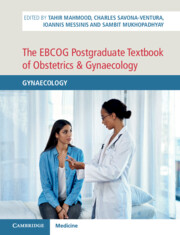Book contents
- The EBCOG Postgraduate Textbook of Obstetrics & Gynaecology
- The EBCOG Postgraduate Textbook of Obstetrics & Gynaecology
- Copyright page
- Dedication
- Contents
- Videos
- Contributors
- Preface
- Section 1 Basic Sciences in Gynaecology
- Section 2 Menstrual Disorders
- Section 3 Reproductive Endocrinology and Infertility
- Section 4 Contraception and STIs
- Section 5 Post-Reproductive Care
- Section 6 Vulva and Vagina
- Section 7 Cervix
- Section 8 Uterus
- Section 9 Ovary and Fallopian Tubes
- Section 10 Operative Gynaecology
- Section 11 Public Health Issues in Gynaecology
- Chapter 51 Clinical Governance in Gynaecology
- Chapter 52 Prevention of Unintended Pregnancy
- Chapter 53 HPV Immunization
- Chapter 54 Screening for Gynaecological Cancers
- Chapter 55 Female Genital Mutilation/Cutting
- Chapter 56 Genetics and Gynaecological Disease
- Chapter 57 Legal and Ethical Issues in Gynaecological Practice
- Section 12 Miscellaneous
- Index
- Plate Section (PDF Only)
- References
Chapter 53 - HPV Immunization
from Section 11 - Public Health Issues in Gynaecology
Published online by Cambridge University Press: 24 November 2021
- The EBCOG Postgraduate Textbook of Obstetrics & Gynaecology
- The EBCOG Postgraduate Textbook of Obstetrics & Gynaecology
- Copyright page
- Dedication
- Contents
- Videos
- Contributors
- Preface
- Section 1 Basic Sciences in Gynaecology
- Section 2 Menstrual Disorders
- Section 3 Reproductive Endocrinology and Infertility
- Section 4 Contraception and STIs
- Section 5 Post-Reproductive Care
- Section 6 Vulva and Vagina
- Section 7 Cervix
- Section 8 Uterus
- Section 9 Ovary and Fallopian Tubes
- Section 10 Operative Gynaecology
- Section 11 Public Health Issues in Gynaecology
- Chapter 51 Clinical Governance in Gynaecology
- Chapter 52 Prevention of Unintended Pregnancy
- Chapter 53 HPV Immunization
- Chapter 54 Screening for Gynaecological Cancers
- Chapter 55 Female Genital Mutilation/Cutting
- Chapter 56 Genetics and Gynaecological Disease
- Chapter 57 Legal and Ethical Issues in Gynaecological Practice
- Section 12 Miscellaneous
- Index
- Plate Section (PDF Only)
- References
Summary
Vaccines against HPV are highly efficacious in preventing infection and disease in the cervix, vulva, anus, oropharynx as well as the anogenital warts caused by HPV types included in the vaccine cocktail. The efficacy is optimal if vaccines are given in prepubertal girls and boys before coitarche, while it remains an individual choice for older women. Vaccination is efficacious in women who have been infected but cleared the infection, although the upper age of vaccination depends on cost-effectiveness and is country-specific. School-based gender-neutral vaccination optimizes coverage and herd immunity. Two doses suffice under the age of 15 with an interval of 6–12 months, while the standard three-dose regimen is recommended thereafter. Vaccine will modify screening strategies, possibly with longer screening intervals in vaccinated cohorts, but will not obviate them. Vaccination in low-resource setting is especially important as lack of infrastructure prevents screening, but affordability remains a major issue.
- Type
- Chapter
- Information
- The EBCOG Postgraduate Textbook of Obstetrics & GynaecologyGynaecology, pp. 457 - 466Publisher: Cambridge University PressPrint publication year: 2021

